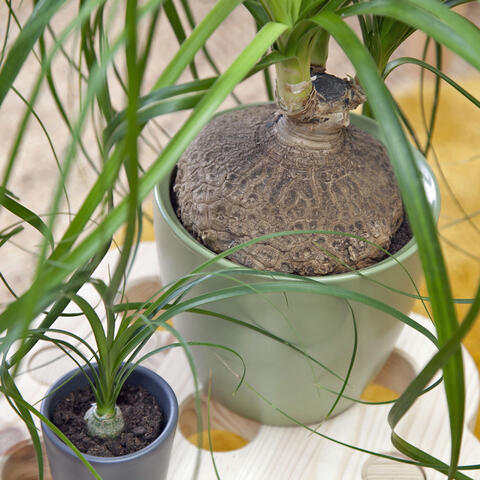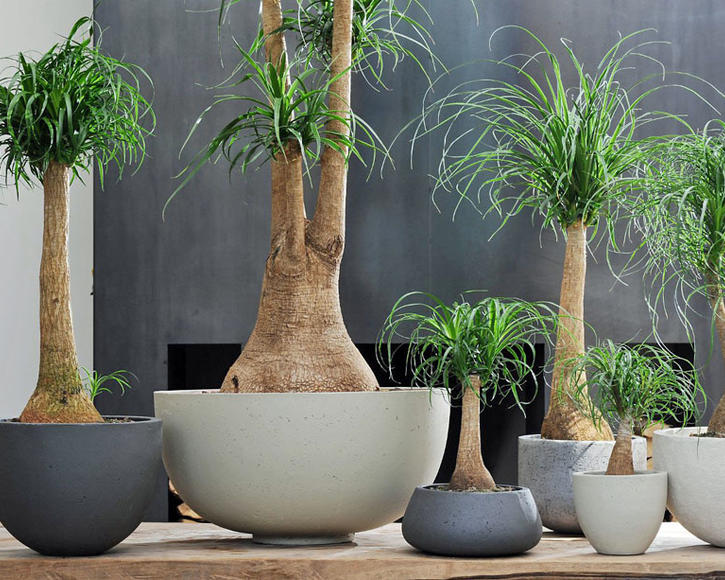Elephant’s foot
The easy-care Elephant’s foot, also known as the Beaucarnea, Nolina or ponytail palm, originates from Mexico. It is the perfect houseplant for beginners.
Factsheet
- Growth type
-
- large shrub
- Growth height (from)
- from 50 cm to 300 cm
- Growth width (from)
- from 50 cm to 100 cm
- Growth characteristics
-
- upright
- Flower color
-
- white
- Flowering time (month)
-
- August to September
- Flower shape
-
- Panicules
- Flower characteristics
-
- unimpressive
- Leaf color
-
- green
- page format
-
- long pointed
- oblong
- strap-shaped
- narrow-length
- Sheet properties
-
- evergreen
- Light
-
- sunny to scattered light
- Soil type
-
- sandy to loamy
- Soil Moisture
-
- moderately dry to fresh
- ph value
-
- weakly acidic
- Lime compatibility
-
- lime-tolerant
- Nutrient requirements
-
- moderately nutritious
- Humus
-
- low humus
- Decorative or utility value
-
- Leaf ornaments
- picturesque growth
- Toxicity
-
- toxic
- Winter Hardness
-
- frost-sensitive
- Use
-
- Interior greening
- Planters
- Winter garden
The Elephant’s foot (Beaucarnea recurvata), also goes by the name of the ponytail palm and can often also be found commercially under its old generic name, Nolina. The tree originates from Mexico. In its native region, it grows in tropical, dry forests as a succulent tree and can reach a height of approx. 30 feet, while the trunk grows to a diameter of three feet. However, in pots the Elephant’s foot remains much smaller. It belongs to the Asparagaceae family and is related to the Yucca plant, among others. It’s habitus is similar to the Australian bottle tree, also known as the Kurrajong, however, they are not related.
The Elephant’s foot is robust, extremely long-living and very easy-care. It is particularly suitable as a houseplant or office plant for beginners, as it is very forgiving to the odd care mistake.
The plant has a round, thickened trunk base and dense, overhanging, narrow leaves. It’s unusual habitus is reminiscent of the shape of an Elephant’s foot, hence the name. Although the Elephant’s foot grows very slowly, it can reach a height of nearly 5 feet after a few years. The unusual, thickened, barky trunk acts as a reservoir. Above the thickened section, the elephant’s foot generally continues to grow upwards in a single shoot, but more rarely also as several shoots.
The grey-green and very narrow, loose, downward hanging leaves can grow up to 20 inches long and are radially positioned around the shoot. As with the Yucca and the Dragon tree, these grow from the shoot tips and die off bit by bit, so that only the ends of the shoots have leaves.
In extremely favorable, i.e. warm, sunny locations, after many years it forms long panicles with small, white flowers, however even older plants rarely flower in indoor cultivation.

As a true child of the desert, the Elephant’s foot loves a place in the sun with full light. It’s slow growth pace slows even further in the shade. The summer temperatures can get as high as the weather determines. However, strong midday heat should be weakened with blinds or shadow creating leaves in front of the window, as otherwise, the ornamental foliage burns very quickly. In winter, the temperature should be between 50 and 60 degrees Fahrenheit. The Elephant’s foot quickly gets very cold feet in a draft, so it should be spared generous spaces. It can also be readily cultivated outside in the summer, however, in this case it should be acclimatized step by step to a new location over a period of two weeks. This can be done by first placing the plant in a more shady position, then edging it towards a lighter spot every few days until the leaves have become acclimatized to the bright sunlight.
The Elephant’s foot requires extremely permeable, loose earth. Permeable cactus soil is a suitable substrate, as is humus-rich leaf mold mixed with plenty of coarse sand.
The Elephant’s foot does not require much water due to its succulent trunk. It should therefore only be moderately watered during the growth phase. The status of the substrate can be easily checked with a finger test. The Elephant’s foot should be watered until the first drops trickle out of the drainage hole. Frequent watering should be avoided, as otherwise the leaves turn brown, and waterlogging inevitably leads to root tot. The excess water should be able to drain off easily, or poured out of the planter after watering. It should not be watered at all during its resting period in the winter, unless it is has been placed somewhere quite warm.
The Elephant’s foot also requires very little fertilizer as it can survive on a minimum of nutrients. Ideally, it should be fertilized once in the spring and once in the summer with liquid cactus fertilizer. Do not fertilize at all in the winter.
The plants grow extremely slowly and do very well with just a minimal amount of substrate as they can store water and nutrients in their trunks. Therefore, it only needs re-potting when the thickened trunk base almost fills the surface of the plant pot or if the root ball has already started to protrude out of the container. The ideal time to re-pot is in the early spring from mid-February to the end of March. As the Elephant’s foot has a fibrous root system, it is advisable to choose a flat plant container. This also puts the thickened foot on display.

The Elephant’s foot can be trimmed back at any time. The trunk can be trimmed at any height in order to stimulate the formation of side shoots below the cut surface. However, you should prevent the cut surface from drying out by treating it with a cicatrizing agent.
Side shoots from large Elephant’s foot plants are suitable for propagation. The side shoots which form in the leaf axils are taken as cuttings in the summer and placed in a sand/turf mixture. The root formation is most reliable with a constant soil temperature in a closed growing bed so that the cutting is protected against moisture loss.
A more common and successful method is propagation with seeds, as the trunk is then better able to develop its typical shape. However, seed collection is difficult, as the plants only rarely flower and produce fruit. Although it is possible to buy Beaucarnea recurvata seeds online.
If the young leaves become soft and yellow, this is usually due to poor care. A possible cause is root damage due to waterlogging. The plant’s leaves also sometimes turn yellow as a result of heavily fluctuating temperatures in the winter. If the plant pots are standing on a cold stone base, you should place a wooden board or Styrofoam sheet underneath the pots in the winter to isolate the root ball from the cold ground.
Dry air can lead to spider mites and scaly insects. Spider mite webs can be easily recognized on the leaf axils and margins. As scaly insects are well camouflaged, the elephant’s foot plant should be regularly checked for infestation, particularly in the winter. Elephant’s foot is also occasionally infested by mealy bugs which have webs reminiscent of cotton balls and are easy to recognize. It is essential to isolate the infested leaves and treat the remaining foliage with a light, soft soapy solution to prevent further infestation.
Frequently Asked Questions
What is an Elephant’s foot plant?
The Elephant’s foot is a succulent tree which is actually native to the tropical, dry forests of Mexico. It’s round, thickened trunk base is reminiscent of the shape of an elephant’s foot - hence the name. However, it is also known as the ponytail palm or Nolina. Outside of its native region, the Elephant’s foot is a popular houseplant for beginners, as it requires hardly any care.
What kind of soil is suitable for the Elephant’s foot?
A permeable cactus soil is ideal. Alternatively, you can also mix humus-rich leaf mulch with coarse sand.
How often should Elephant’s foot be watered?
Elephant’s foot should not be watered too often, but when watering, do so until the water starts to trickle out of the drainage hole. It is essential to pour off any excess water from the plant pot surface, because the Elephant’s foot is very sensitive to waterlogging. If the Elephant’s foot is not kept in too warm a place in the winter then it does not require any watering.
What kind of fertilizer is suitable for Elephant’s foot?
Elephant’s foot only requires fertilizing in the spring and summer. A cactus fertilizer is ideal.
When does an Elephant’s foot need re-potting?
Elephant’s foot only needs re-potting if the plant pot surface is almost completely covered by the trunk base. The perfect time is from mid-February to the end of March.
How quickly does the Elephant’s foot grow?
Elephant’s foot grows very slowly and takes several years to reach 3 feet tall.

